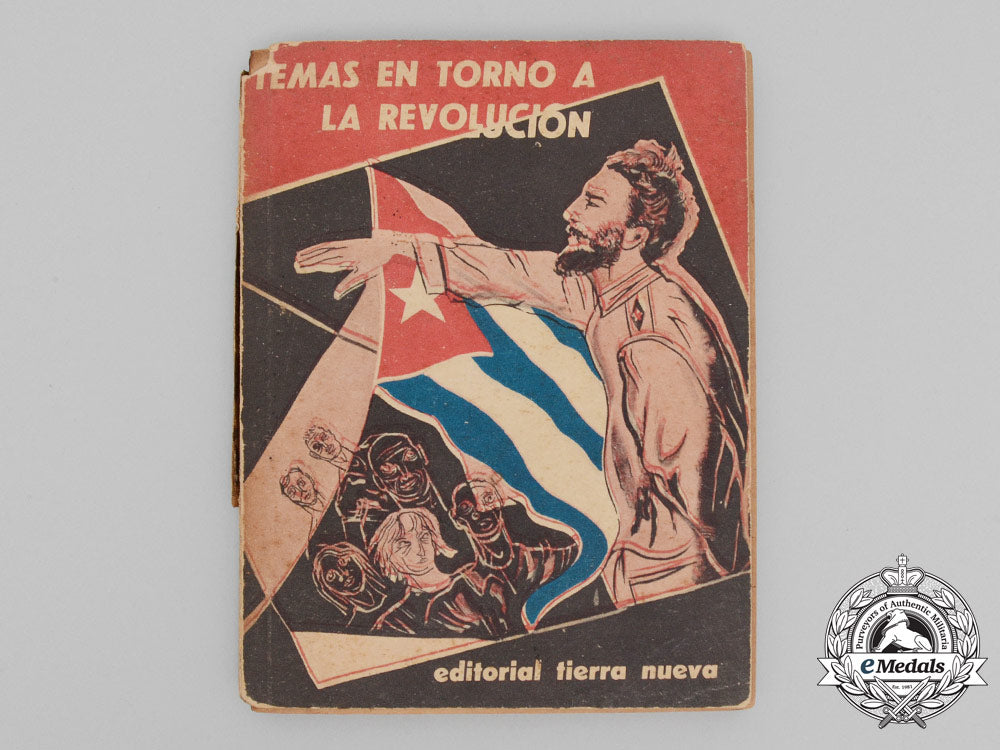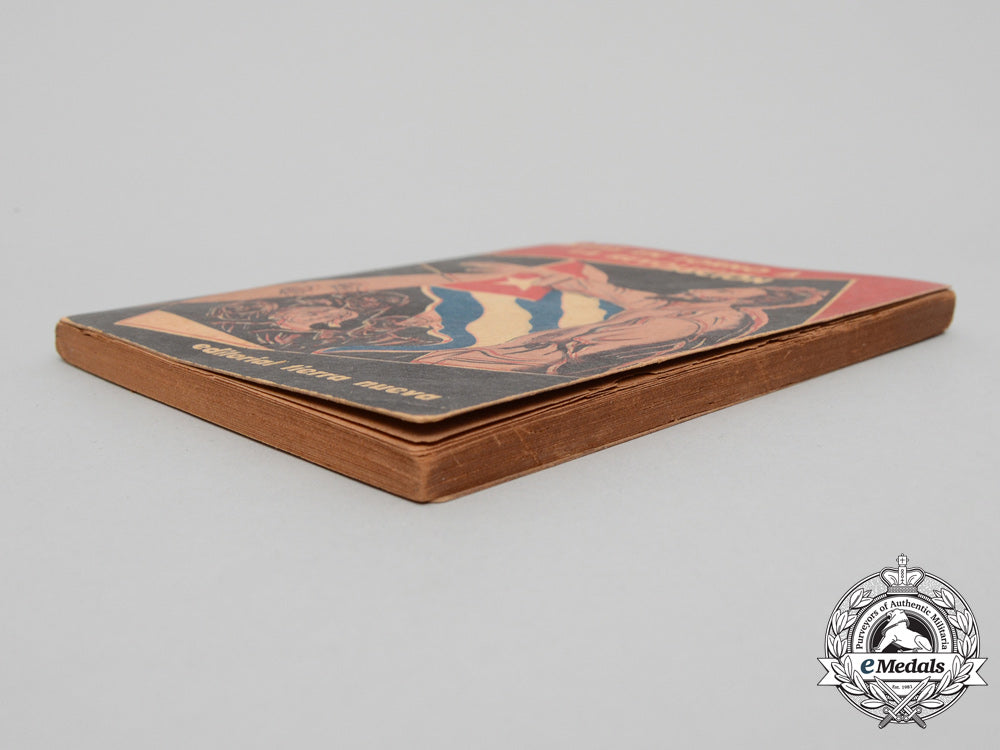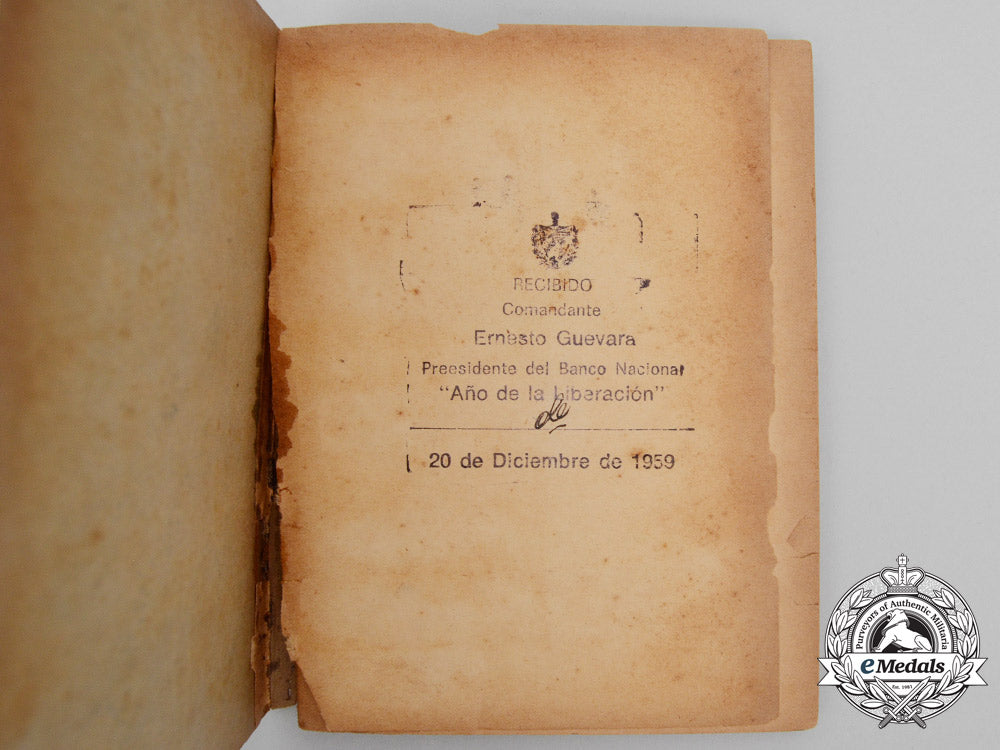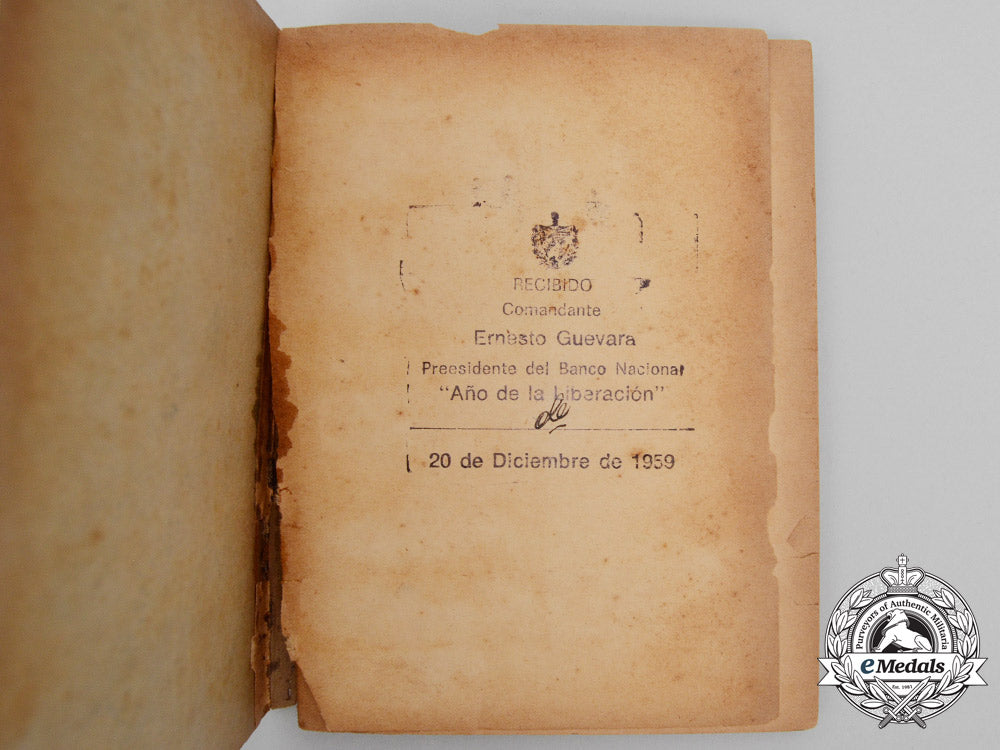
LOADING ...
In response to evolving domestic opinion, eMedals Inc has made the conscious decision to remove the presentation of German Third Reich historical artifacts from our online catalogue. For three decades, eMedals Inc has made an effort to preserve history in all its forms. As historians and researchers, we have managed sensitive articles and materials with the greatest of care and respect for their past and present social context. We acknowledge the growing sentiments put forth by the Canadian public and have taken proactive actions to address this opinion.



Cuba, Republic., An "Issues Regarding The Revolution" Book Signed By Ernesto "Che" Guevara
Cuba, Republic., An "Issues Regarding The Revolution" Book Signed By Ernesto "Che" Guevara
SKU: ITEM: W4094
Current Bid:
Your Max Bid:
Bid History:
Time Remaining:
Couldn't load pickup availability
Shipping Details
Shipping Details
eMedals offers rapid domestic and international shipping. Orders received prior to 12:00pm (EST) will be shipped on the same business day.* Orders placed on Canadian Federal holidays will be dispatched the subsequent business day. Courier tracking numbers are provided for all shipments. All items purchased from eMedals can be returned for a full monetary refund or merchandise credit, providing the criteria presented in our Terms & Conditions are met. *Please note that the addition of a COA may impact dispatch time.
Shipping Details
eMedals offers rapid domestic and international shipping. Orders received prior to 12:00pm (EST) will be shipped on the same business day.* Orders placed on Canadian Federal holidays will be dispatched the subsequent business day. Courier tracking numbers are provided for all shipments. All items purchased from eMedals can be returned for a full monetary refund or merchandise credit, providing the criteria presented in our Terms & Conditions are met. *Please note that the addition of a COA may impact dispatch time.
Description
Description
Front cover entitled in Spanish "TEMAS EN TORNO A LA REVOLUCIÓN" (Issues Regarding the Revolution), with a subheading inscribed "editorial tierra nueva" (publishing new land), illustrating a caricature of Fidel Castro orating to a group of people with the Cuban flag in the background, first page stamped "RECIBIDO Comandante Ernesto Guevara Preesidente del Banco Nacional "Ano de la Liberacion" 20 de Diciembre de 1959" and signed "Che" in black ink on the stamp, divided into six sections (entitled: 1. "La Reforma Agraria Cubana" (Cuban Agrarian Reform) by Ignacio Duarte, 2. "America del Sur Frente a la Revolucion Cubana" (South America Faced with the CubanRevolution) by Rafael Humberto Gaviria, 3. "Que es un "Guerrillero" (What is a "Guerilla") by Ernesto "Che" Guevera, 4. "Tres Cuentos" (Three Tales) by Jose Lorenzo, 5. "El Desalojo de las Maboas" (Eviction of Maboas) by Gregorio Ortega and 6. "La Revolucion Humanista" (The Humanist Revolution) by Euclides Vazquez Candela), three lines of highlighted text appearing on page 68, printed by Ramello Lithography of Havana on July 20, 1959, cover printed in red, blue and black inks on a card stock, wrapped around and glued in place to the text incorporating 144 pages printed in black ink and dual-staple bound, 113 mm x 145 mm, cover has separated from the text and exhibits wear, age soiling on the cover and the first few pages at the front and back of the booklet, foxing on the pages throughout, fine.
Footnote: Ernesto "Che" Guevara (June 14, 1928 - October 9, 1967), commonly known as El Che or simply Che, was an Argentine Marxist revolutionary, physician, author, guerrilla leader,diplomat, and military theorist. A major figure of the Cuban Revolution, his stylized visage has become a ubiquitous countercultural symbol of rebellion and global insignia in popular culture. As a young medical student, Guevara travelled throughout South America and was radicalized by the poverty, hunger, and disease he witnessed. His burgeoning desire to help overturn what he saw as the capitalist exploitation of Latin America by the United States prompted his involvement in Guatemala's social reforms under President Jacobo Árbenz, whose eventual CIA-assisted overthrow at the behest of the United Fruit Company solidified Guevara's political ideology. Later, in Mexico City, he met Raúl and Fidel Castro, joined their 26th of July Movement, and sailed to Cuba aboard the yacht Granma, with the intention of overthrowing U.S.-backed Cuban dictator Fulgencio Batista. Guevara soon rose to prominence among the insurgents, was promoted to second-in-command, and played a pivotal role in the victorious two-year guerrilla campaign that deposed the Batista regime. Following the Cuban Revolution, Guevara performed a number of key roles in the new government. These included reviewing the appeals and firing squads for those convicted as war criminals during the revolutionary tribunals, instituting agrarian land reform as minister of industries, helping spearhead a successful nationwide literacy campaign, serving as both national bank president and instructional director for Cuba's armed forces, and traversing the globe as a diplomat on behalf of Cuban socialism. Such positions also allowed him to play a central role in training the militia forces who repelled the Bay of Pigs Invasion and bringing the Soviet nuclear-armed ballistic missiles to Cuba, which precipitated the 1962 Cuban Missile Crisis. Additionally, he was a prolific writer and diarist, composing a seminal manual on guerrilla warfare, along with a best-selling memoir about his youthful continental motorcycle journey. His experiences and studying of Marxism-Leninism led him to posit that the Third World's underdevelopment and dependence was an intrinsic result of imperialism, neocolonialism, and monopoly capitalism, with the only remedy being proletarian internationalism and world revolution. Guevara left Cuba in 1965 to foment revolution abroad, first unsuccessfully in Congo-Kinshasa and later in Bolivia, where he was captured by CIA-assisted Bolivian forces and summarily executed.
Description
Front cover entitled in Spanish "TEMAS EN TORNO A LA REVOLUCIÓN" (Issues Regarding the Revolution), with a subheading inscribed "editorial tierra nueva" (publishing new land), illustrating a caricature of Fidel Castro orating to a group of people with the Cuban flag in the background, first page stamped "RECIBIDO Comandante Ernesto Guevara Preesidente del Banco Nacional "Ano de la Liberacion" 20 de Diciembre de 1959" and signed "Che" in black ink on the stamp, divided into six sections (entitled: 1. "La Reforma Agraria Cubana" (Cuban Agrarian Reform) by Ignacio Duarte, 2. "America del Sur Frente a la Revolucion Cubana" (South America Faced with the CubanRevolution) by Rafael Humberto Gaviria, 3. "Que es un "Guerrillero" (What is a "Guerilla") by Ernesto "Che" Guevera, 4. "Tres Cuentos" (Three Tales) by Jose Lorenzo, 5. "El Desalojo de las Maboas" (Eviction of Maboas) by Gregorio Ortega and 6. "La Revolucion Humanista" (The Humanist Revolution) by Euclides Vazquez Candela), three lines of highlighted text appearing on page 68, printed by Ramello Lithography of Havana on July 20, 1959, cover printed in red, blue and black inks on a card stock, wrapped around and glued in place to the text incorporating 144 pages printed in black ink and dual-staple bound, 113 mm x 145 mm, cover has separated from the text and exhibits wear, age soiling on the cover and the first few pages at the front and back of the booklet, foxing on the pages throughout, fine.
Footnote: Ernesto "Che" Guevara (June 14, 1928 - October 9, 1967), commonly known as El Che or simply Che, was an Argentine Marxist revolutionary, physician, author, guerrilla leader,diplomat, and military theorist. A major figure of the Cuban Revolution, his stylized visage has become a ubiquitous countercultural symbol of rebellion and global insignia in popular culture. As a young medical student, Guevara travelled throughout South America and was radicalized by the poverty, hunger, and disease he witnessed. His burgeoning desire to help overturn what he saw as the capitalist exploitation of Latin America by the United States prompted his involvement in Guatemala's social reforms under President Jacobo Árbenz, whose eventual CIA-assisted overthrow at the behest of the United Fruit Company solidified Guevara's political ideology. Later, in Mexico City, he met Raúl and Fidel Castro, joined their 26th of July Movement, and sailed to Cuba aboard the yacht Granma, with the intention of overthrowing U.S.-backed Cuban dictator Fulgencio Batista. Guevara soon rose to prominence among the insurgents, was promoted to second-in-command, and played a pivotal role in the victorious two-year guerrilla campaign that deposed the Batista regime. Following the Cuban Revolution, Guevara performed a number of key roles in the new government. These included reviewing the appeals and firing squads for those convicted as war criminals during the revolutionary tribunals, instituting agrarian land reform as minister of industries, helping spearhead a successful nationwide literacy campaign, serving as both national bank president and instructional director for Cuba's armed forces, and traversing the globe as a diplomat on behalf of Cuban socialism. Such positions also allowed him to play a central role in training the militia forces who repelled the Bay of Pigs Invasion and bringing the Soviet nuclear-armed ballistic missiles to Cuba, which precipitated the 1962 Cuban Missile Crisis. Additionally, he was a prolific writer and diarist, composing a seminal manual on guerrilla warfare, along with a best-selling memoir about his youthful continental motorcycle journey. His experiences and studying of Marxism-Leninism led him to posit that the Third World's underdevelopment and dependence was an intrinsic result of imperialism, neocolonialism, and monopoly capitalism, with the only remedy being proletarian internationalism and world revolution. Guevara left Cuba in 1965 to foment revolution abroad, first unsuccessfully in Congo-Kinshasa and later in Bolivia, where he was captured by CIA-assisted Bolivian forces and summarily executed.



You May Also Like
Germany, SA. A Model 1933 Service Dagger, SA-Gruppe Nordsee, by Friedrich von der Kohlen
G59818
Germany, SA. A Model 1933 Service Dagger, SA-Gruppe Pommern, by Gustav Wirth
G59816
Germany, Third Reich. A Mixed Lot of Tyrolean Marksmanship Badges
G52930
Germany, SS. An Estonian Waffen-SS Volunteer’s Sleeve Shield
G50381
Germany, SS. A Waffen-SS Sturmmann Sleeve Insignia
G52846
-
Germany, SA. A Model 1933 Service Dagger, SA-Gruppe Nordsee, by Friedrich von der Kohlen
G59818
Add to CartRegular price $980 USDRegular price $0 USD Sale price $980 USDUnit price / per -
Germany, SA. A Model 1933 Service Dagger, SA-Gruppe Pommern, by Gustav Wirth
G59816
Add to CartRegular price $980 USDRegular price $0 USD Sale price $980 USDUnit price / per -
Germany, Third Reich. A Mixed Lot of Tyrolean Marksmanship Badges
G52930
Add to CartRegular price $135 USDRegular price $0 USD Sale price $135 USDUnit price / per -
Germany, SS. An Estonian Waffen-SS Volunteer’s Sleeve Shield
G50381
Add to CartRegular price $150 USDRegular price $0 USD Sale price $150 USDUnit price / per -
Germany, SS. A Waffen-SS Sturmmann Sleeve Insignia
G52846
Add to CartRegular price $135 USDRegular price $0 USD Sale price $135 USDUnit price / per
Do you have a similar item you are interested in selling?
Please complete the form and our client care representatives will contact you.
Sell Item










